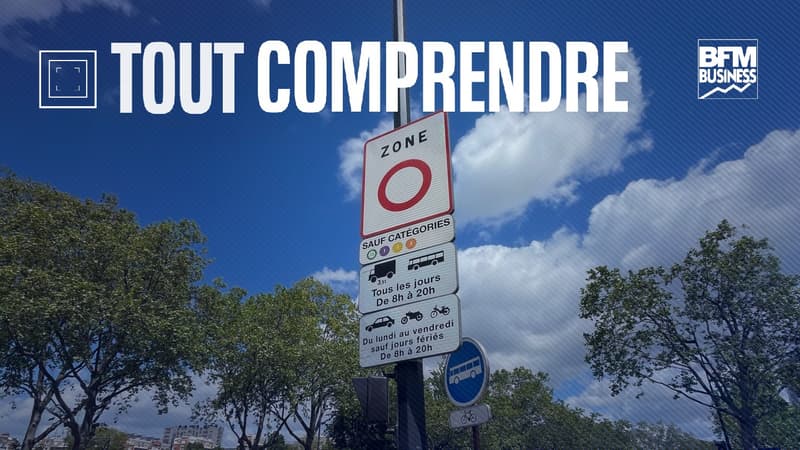New episode in the long soap opera of the implementation of low -emission areas (ZFE) in France. The parliamentarians go up to slots in recent weeks to return to a measure far from being unanimous.
At the end of March, a deputy of RN had an amendment voted in the committee to eliminate ZFES, as part of the text committee exam on the simplification of economic life. A first step because the text must be adopted by the National Assembly and the Senate. This session exam should start this Tuesday, April 8.
Another bill will also be presented in the coming weeks for 35 deputies of law, the modem and the Liot group. It requires a suspension of this device, with a five -year moratorium. A kind of rest, after years of “pedagogy” and cacophony around a possible automatic verbalization of criminals.
“It is likely that the automatic fines of 2026 have the effect of a ‘social bomb’,” summarized the deputy Les Républicins Sylvie Bonnet, one of the elected officials at the origin of the bill.
Manifestations were also made this weekend to denounce the ZFES, especially under the auspices of the angry motorcyclists.
• Why configure ZFE?
Specifically, the objective of these ZFE has always been to improve air quality in large cities excluding the most polluting vehicles of traffic through the critical sticker system.
The first ZFES created almost 10 years ago, 2025 marked an important step: all the agglomerations of more than 150,000 inhabitants had to have created it.
A very theoretical application still: only four main agglomerations, Paris, Lyon, Grenoble and Montpellier“prohibited” to traffic Vehicles criticize 3 (Diesel before 2011 and gasoline before 2006). But without effective verbalization.
• When should automatic verbalization be launched?
This is the big question that arises, while the deputies want to suspend or suppress these ZFE due to this threat of a verbalization that would weigh the motorists who do not have the right miniature. With a fine of 68 euros.
No Metropolis has really announced the implementation of this automatic verbalization that would pass through cameras for reading plates.
In Lyon, Mayor Grégory Doucet assumed at the beginning of the year to the sanction of “enforcing the law”, but municipal police controls provide controls.
An article in the Tribune of Lyon mentioned “more than 5,800 tickets” prepared between January and August 2024, but with 85% to sanction the absence of critical decal.
Two deadlines suggested that no initiative on this verbalization would have been taken before at least two and a half years: the municipal elections in 2026 and the presidential elections in 2027.
The mayor of Montpellier, for example, promised not to go to this sanction component before the end of his term, said an article last January.
The state and agglomerations also constantly refer to the ball in which the camera system for this automatic verbalization will have to install and manage.
“It is a state promise (…) that had promised to provide them with the municipalities related to ZFE in 2022. These radars are common sense,” Grégory Doucet added to the BFM Lyon antenna.
But again, nothing official, and the implementation of an educational period, once again in 2025, suggested a verbalization at least by 2026.
• Why this fear around ZFE?
This vagueness around a possible verbalization of criminals crystallizes criticism around the ZFE. And for a good reason, during the night, millions of motorists would be prohibited to circulate in most French agglomerations.
Only for Crit’Air 3, almost 9 million cars would be affected nationwide, according to AAA data data.
If we take the park more directly affected daily by the ban, in the Grand Paris metropolis, for example, we are still at 1.12 million criticized vehicles 3 in Ile-de-France. And even 1.58 million vehicles if we add the other “prohibited” vehicles, critic 4, 5 and the stickers.
• What possible arrangements?
ZFES implementation also meets a European public health policy aimed at improving air quality by reducing different pollutants. Failure to comply with certain contamination thresholds exposes France to sanctions.
Eliminating areas with low emissions (ZFE) could cost France more than 3 billion euros in European aid, according to a note from the General Treasury Directorate. A sum that includes a reimbursement of the subsidies already obtained and the loss of future funds.
In this context, the idea would be to develop ZFE’s implementation instead of eliminating them.
The Minister of Ecological Transition, for example, proposed to make ZFE mandatory only for agglomerations that exceed the regulatory thresholds of air quality for three of the last five years. This would be equivalent to re -focusing these obligations in the Metropolis of Paris and Lyon at the beginning.
This current debate will undoubtedly allow you to see a little more clearly about the establishment of these ZFE. What also responds to a certain frustration of those who have changed vehicles to adapt to an announced regulation, but that (yet) does not apply (yet), as for those who do not have the means to buy a more recent context of lower purchase help.
Source: BFM TV


